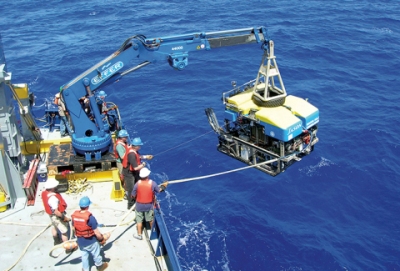Dec 31 2013
Scientists and engineers using advanced technology and a unique robotic vehicle to study the deep sea will also be using their computers to interact with students, teachers, and the public about the research they are conducting.
 Researchers will use the remotely operated vehicle Jason to study microbes living on and below the seafloor during the latest expedition in the Dive and Discover educational series, which kicks off on January 2, 2014. The international research team includes scientists from nine countries. Photo by: Tom Bolmer, Woods Hole Oceanographic Institution
Researchers will use the remotely operated vehicle Jason to study microbes living on and below the seafloor during the latest expedition in the Dive and Discover educational series, which kicks off on January 2, 2014. The international research team includes scientists from nine countries. Photo by: Tom Bolmer, Woods Hole Oceanographic Institution
Working along the East Pacific Rise, a mid-ocean ridge about 600 miles south of Manzanillo, Mexico, aboard the research vessel Atlantis, scientists from Woods Hole Oceanographic Institution (WHOI) and their colleagues will examine life in some of the most extreme environments on Earth—deep-sea hydrothermal vents.
The scientists’ work will be chronicled in video, still images, and daily written updates on WHOI’s Dive and Discover website from January 2-22, 2014. Website visitors will be able to experience much of what the scientists are seeing and learning during the research mission, including incredible video of the deep sea taken by the remotely operated vehicle Jason, and learn about life aboard a working research vessel. Interviews with ship’s crew, scientists, engineers, and others, give visitors insight into the many people it takes to run a successful research expedition. The Dive and Discover site also features in-depth explanations of ocean phenomenon, interactive illustrations to illuminate deep-sea features and animals, classroom activities and educational resources for teachers, and a "Mail Buoy" that allows students and others to communicate directly by email with scientists at sea.
The expedition is the 15th on the Dive and Discover website, which was created in 2000 to provide young people access to the latest oceanographic and deep submergence research as it happens. Since then, the site has become a unique resource for teachers, students and the public, receiving more than half a million visitors each year.
The latest expedition is called ‘Dark Life at Deep-sea Vents.’ Unlike ecosystems on Earth’s surface, where sunlight provides energy, deep-sea vents exist in total darkness.
“There’s no light coming in at all to these systems,” said Stefan Sievert, a biologist at WHOI and chief scientist on the expedition. “All the energy supporting these ecosystems is coming from the inner Earth.”
Since the late 1970s when deep-sea hydrothermal vent sites were first discovered, scientists have known that microbes derive their energy from chemicals that flow out of the hydrothermal vents. But they haven’t yet discovered exactly how they do it. What sorts of microbes are down there, which chemicals are they using, and how fast are they growing? What role do these microbes play in the food web, both at the vents and in the rest of the deep ocean? Scientists will be looking for answers to those questions during the expedition.
In addition to the Jason vehicle, the research team will utilize Isobaric Gas-Tight samplers, which can suck in microbes along with the fluids and maintain them at the same deep-sea pressure as they come up to the surface. Scientists will then perform experiments onboard the ship to study the activities of the microbes in more detail at simulated seafloor conditions. They will further analyze the DNA, RNA, and proteins of the microbes collected at the seafloor to learn more about their genetic makeup and physiology, and bring samples of microbes back to shore for further study.
“We’ll be able to look at the genes of an individual microbe. And if you know how small a microbe is, that’s quite a difficult task,” said marine chemist Jeff Seewald, a co-principal investigator of the expedition. “Technology now exists that we can look at the genetic material in individual cells, see who is there, and possibly what they’re doing on the seafloor.”
Chief scientist Stefan Sievert will also participate in a live phone call from sea with visitors at the Ocean Explorium in New Bedford, Mass., on January 16, as part of the museum’s “Family Science Nights.”